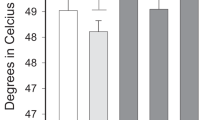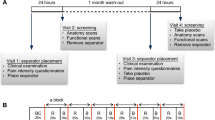Abstract
The analgesic effects of the synthetic opiate fentanyl citrate (0.1 mg) on subjective pain reports (SPR) and late-wave event-related potentials (ERP) recorded during painful dental stimulation were examined in human subjects. Such waves have been shown to reflect the contribution of cognitive variables, such as expectancy and belief, to perception. In addition, the study was intended to demonstrate a dose-related narcotic antagonism with injection of naloxone (1.2 or 0.4 mg) or normal saline (double-blind) following IV fentanyl administration. Fentanyl reduced both ERP waveform amplitudes and SPR as have previously studied analgesic agents, such as nitrous oxide, acupuncture, and aspirin. Naloxone injection reversed both ERP and SPR changes, but surprisingly, a reversal of narcotic analgesia equal to that of 0.4 mg naloxone was seen with saline injection. By change, all subjects were health-science students or professionals who were knowledgeable in opiate pharmacology, and so placebo reversal was hypothesized. Alternatively, it was hypothesized that fentanyl cleared more rapidly than predicted, thus, producing apparent reversal. In a second experiment involving similarly knowledgeable subjects with identical procedures and testing intervals, subjects received 0.1 mg fentanyl, but no reversal injection. The fentanyl effect was constant across this time period. The data, thus support the hypothesis that the saline-induced reversal seen in experiment 1, where the subjects were knowledgeable in opiate pharmacology, was placebo opiate antagonism.
Similar content being viewed by others
References
Benedetti C, Chapman CR, Colpitts YH, Chen AC (1982) Effect of nitrous oxide concentration on event-related potentials during painful tooth stimulation. Anesthesiology 56:360–364
Buchsbaum MS, Davis GC, Bunney WE (1977) Naloxone alters pain perception and somatosensory evoked potentials in normal subjects. Nature 270:620–622
Buchsbaum MS, Davis GC, Coppola R, Naber D (1981) Opiate pharmacology and individual differences. II. Somatosensory evoked potentials. Pain 10:367–377
Chapman CR, Benedetti C (1979) Nitrous-oxide effects on cerebral evoked potential: Partial reversal with a narcotic antagonist. Anesthesiology 51:135–138
Chapman CR, Benedetti C, Butler SH (1977) Cerebral response measures of stimulation-induced and opiate-induced dental analgesia in man: Attempted analgesia reversal with narcotic antagonist. In: Anderson DJ, Matthews B (eds) Pain in the trigeminal region. Elsevier-North Holland Biomedical, Amsterdam, pp 423–433
Chapman CR, Colpitts YM, Benedetti C, Kitaeff R, Gehrig JD (1980) Evoked potential assessment of acupunctural analgesia: Attempted reversal with naloxone. Pain 9:183–197
Chapman CR, Colpitts YM, Benedetti C, Butler S (1982) Event-related potential correlates of analgesia: Comparison of fentanyl, acupuncture and nitrous oxide. Pain 14:327–337
Chen ACN, Chapman CR (1980) Aspirin analgesia evaluated by eventrelated potentials in man. Possible central action in brain. Exp Brain Res 39:359–364
Chen ACN, Chapman CR, Harkins SW (1979) Brain evoked potentials are functional correlates of induced pain in man. Pain 6:365–374
Cohen J, Burns P (1976) MANOVA. Northwestern University, Chicago IL
Gehrig JD, Colpitts YH, Chapman CR (1981) Effects of local anesthetic infiltration on brain potentials evoked by painful dental stimulation. Anesth Analg (Cleve) 60:779–782
Goldstein A, Fischli W, Lowney LI, Hunkapiller M, Hood L (1981) Porcine pituitary dynorphin: Complete amino acid sequence of the biologically active heptadecapeptide. Proc Natl Acad Sci USA 78:7219–7223
Gray TC, Nunn JF, Utting JE (1980) General anaesthesia, vol I. Butterworths, London, p 267
Harkins SW, Chapman CR (1978) Cerebral evoked potentials to noxious dental stimulation: Relationship to subjective pain report. Psychophysiology 15:248–252
Hillyard SA, Picton TW (1979) Event-related brain potentials and selective information processing in man. In: Desmedt JE (ed) Progress in clinical neurophysiology, vol 6. Karger, Basel, pp 1–52
Martin RW, Chapman CR (1979) Dental dolorimetry for human pain research: Methods and apparatus. Pain 6:349–364
McNemar Q (1962) Psychological statistics. Wiley, New York
Nie NH, Hull CH, Jenkins JG, Steinbrenner K, Bent DH (1970) Statistical package for the social sciences. McGraw Hill, New York
Rohdewald P, Derendorf H, Drehsen G, Elger CE, Knoll O (1982) Changes in cortical evoked potentials as correlates of the efficacy of weak analgesics. Pain 12:329–341
Schleimer R, Benjamin E, Eisele J, Henderson G (1978) Pharmaco-kinetics of fentanyl as determined by radioimmunoassay. Clin Pharmacocol Ther 23:188–194
Tulunay FC, Jen MF, Chang JK, Loh HH, Lee NM (1981) Possible regulatory role of dynorphin on morphine- and β-endorphin-induced analgesia. J Pharmacol Exp Ther 219:296–298
Author information
Authors and Affiliations
Rights and permissions
About this article
Cite this article
Butler, S.H., Colpitts, Y.H., Gagliardi, G.J. et al. Opiate analgesia and its antagonism in dental event-related potentials: Evidence for placebo antagonism. Psychopharmacology 79, 325–328 (1983). https://doi.org/10.1007/BF00433411
Received:
Accepted:
Issue Date:
DOI: https://doi.org/10.1007/BF00433411




